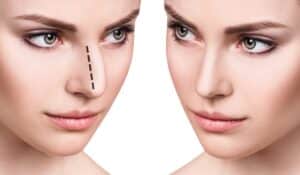The Evolution of Nasal Aesthetics: Non-Surgical Rhinoplasty Innovations

Preparing for Your Procedure
Practitioner Research
Finding the right specialist is crucial. Look for experienced professionals with a focus on nonsurgical rhinoplasty, including plastic surgery procedures for the nasal tip to achieve a new nose or restore a normal nose. They should have a portfolio of before and after photos that showcase their work, including cases, cuts, techniques, and patient satisfaction.
It’s essential to verify their credentials. Ensure they are certified medical practitioners and have positive reviews from previous clients, including patient satisfaction with procedures and evaluation. This step can prevent complications and ensure satisfactory results.
Medication Adjustment
Before your procedure, avoid certain medications and supplements. These include aspirin, ibuprofen, and vitamin E, which can thin your blood, healing bones inside under the guidance of a medical practitioner.
Blood-thinning substances increase the risk of bruising and bleeding during the procedure. Your doctor will provide a list of what to avoid. It’s important to follow these instructions carefully.
Consultation Scheduling
Schedule a detailed consultation with your chosen practitioner. This meeting with the medical practitioner is the time to discuss your aesthetic goals for your face, any concerns you might have about thickness, and healing.
Be prepared to talk about any allergies or reactions you’ve had in the past. This information helps your doctor, or medical practitioner, tailor the procedure to your needs, ensuring safety and effectiveness in healing and the projection of bones.
Understanding the Nonsurgical Approach
Dermal Fillers
Dermal fillers offer a non-invasive alternative to traditional rhinoplasty, targeting the nasal tip and face without affecting bones and requiring less healing time. They can reshape and contour the nose effectively. This method involves injecting fillers into specific areas of the nose, including the nasal tip, to enhance projection and healing of the face. It enhances its shape without the need for surgery.
The process is quick, usually taking less than an hour. Recovery time is minimal, making it a convenient option for many.
Filler Types
Various types of fillers are available, each suitable for different nose shapes and objectives. Hyaluronic acid fillers are popular due to their safety profile and reversibility. They can correct minor asymmetries and smooth out bumps on the bridge of the nose.
Calcium hydroxylapatite is another option, known for its longer-lasting results. However, the choice largely depends on the individual’s goals and the practitioner’s recommendation.
Temporary Nature
One key aspect of nonsurgical rhinoplasty is its temporary nature. Results typically last from six months to two years, depending on the type of filler used. This temporary aspect allows individuals to experiment with their appearance without committing to permanent changes.
For those seeking a more durable solution, surgical rhinoplasty might be considered after experiencing nonsurgical options.
During the Nonsurgical Rhinoplasty
Quick Procedure
Expect a swift experience when opting for nonsurgical rhinoplasty. Typically, it takes only 30 to 45 minutes. This efficiency means less time in the clinic and more immediate results.
Patients appreciate the procedure’s brevity. It allows for minimal disruption to daily activities.
Anesthesia Use
Topical anesthesia plays a crucial role in minimizing discomfort. Before the filler injections, a numbing cream ensures a more comfortable experience.
The use of anesthesia makes the process nearly pain-free. Patients often report feeling only slight pressure or minor pinching sensations.
Visual Adjustments
Prepare for instant visual improvements as the practitioner sculpts your nose, managing any wound. Nonsurgical rhinoplasty allows for immediate adjustments, offering a glimpse of the final outcome right away.
This immediacy is a significant advantage. It provides an opportunity for real-time feedback between patient and practitioner.
Immediate Post-Treatment Care
Ice Application
After undergoing nonsurgical rhinoplasty, managing swelling, bruising, and wound care is crucial. Applying ice packs to the treated wound area can greatly reduce these symptoms. It’s important to wrap the ice in a cloth to avoid direct contact with the skin, especially on a wound. This wound treatment method should be followed for the first few days post-treatment.
Patients should apply ice gently, avoiding excessive pressure that might shift the filler. Typically, using ice for 10-15 minutes every hour on the day of treatment offers significant relief for the wound.
Activity Limitations
Post-treatment care also involves lifestyle adjustments, including wound care, to ensure optimal healing. Wearing glasses, especially those that rest heavily on the nose, should be avoided for at least two weeks. This precaution prevents any undue pressure that could misplace the filler.
Engaging in strenuous activities or exercises is not recommended immediately after treatment. Such activities increase blood flow to the face, potentially exacerbating swelling and affecting the filler’s settling process. A period of rest and minimal activity is advised during the first week following treatment.
Follow-Up Visits
Scheduling a follow-up appointment with your practitioner is essential for monitoring recovery and assessing the need for touch-ups. These check-ups allow practitioners to ensure that the filler maintains its shape and position as intended. They also provide an opportunity to address any concerns or complications that may have arisen post-treatment.
Nonsurgical vs. Surgical Rhinoplasty
Recovery Time
After immediate post-treatment care, the journey to full recovery varies significantly between nonsurgical and surgical rhinoplasty. Nonsurgical options offer minimal downtime, allowing patients to return to their daily activities almost immediately. They might experience slight swelling or bruising, but these side effects typically subside within a few days.
In contrast, surgical rhinoplasty requires a more extended recovery period. Patients often need several weeks to heal fully. The initial few days post-surgery involve managing discomfort and swelling, with a noticeable reduction in symptoms over the following weeks.
Cost Differences
The financial aspect is another critical factor when choosing between nonsurgical and surgical rhinoplasty. Nonsurgical procedures are less expensive upfront. However, they require repeated treatments to maintain results, adding to the overall cost over time.
Surgical rhinoplasty involves a higher initial investment but offers lasting changes without the need for additional treatments. It’s essential for patients to consider both the short-term and long-term financial implications of their choice.

Reversibility
One of the most significant advantages of nonsurgical rhinoplasty is its reversibility. If patients are unsatisfied with the outcome, adjustments can be made, or the effects can gradually fade over time.
Surgical rhinoplasty, however, provides permanent results. While this permanence can be appealing for those seeking long-lasting changes, it also means that any dissatisfaction with the outcome requires corrective surgery.
Advantages of Nonsurgical Rhinoplasty
No Scars
Nonsurgical rhinoplasty leaves no scars. It doesn’t involve cutting the skin. This means patients can avoid the worry of visible scars that might come with surgical options.
They benefit from a smoother process. There’s also no need for general anesthesia, making it safer for those concerned about its risks.
Quick Procedure
This method is remarkably efficient. Most treatments take less than an hour to complete. Patients appreciate the immediate results without waiting weeks for swelling to reduce.
They can return to their daily activities almost instantly. This convenience makes nonsurgical rhinoplasty a popular choice among busy individuals.
Reversible Results
One unique advantage is the ability to adjust or reverse the procedure. If patients are not satisfied, corrections are much simpler compared to surgical methods.
This flexibility offers peace of mind. It allows individuals to experiment with their appearance without permanent commitment.
Potential Drawbacks to Consider
Temporary Results
Nonsurgical rhinoplasty offers a quicker recovery than traditional surgery. However, it’s not permanent. Patients often need follow-up treatments every six to eighteen months. This can add up in terms of time and cost.
They may find the maintenance demanding. Especially if they were hoping for a one-time solution.
Limited Changes
While fillers can smooth out bumps and improve nasal symmetry, there are limits. They cannot reduce nose size or correct significant structural issues.
For those seeking dramatic changes, surgical rhinoplasty might be the only option. This limitation often leads to disappointment among patients with higher expectations.
Complication Risks
Improper filler placement poses serious risks, including skin damage and vascular complications. These can lead to long-term health issues or require corrective surgery.
Patients must choose their practitioner carefully to minimize these risks. Yet, even with an experienced professional, there’s always a chance of unforeseen complications.
Long-Term Results and Expectations
Realistic Expectations
Setting realistic expectations is crucial when considering rhinoplasty. Most people see their final results last between 6 to 18 months. This timeframe varies depending on individual healing processes and the specific techniques used during surgery.
It’s essential to understand that the nose might continue to undergo subtle changes for up to a year post-surgery. These changes are normal as the nose settles into its new shape.
Follow-Up Treatments
Regular follow-up treatments play a significant role in maintaining the desired appearance after rhinoplasty. They help address any minor adjustments or refinements that might be necessary as the nose heals and adapts.
Patients should prepare for these sessions as part of their post-operative care plan. Keeping in close contact with your surgeon ensures any concerns are promptly addressed.
Cost Consideration
The long-term costs and commitment required for upkeep can influence one’s decision between non-surgical rhinoplasty options versus opting for a permanent surgical solution. Non-surgical options, while less invasive, may require ongoing treatments to maintain results, leading to higher cumulative expenses over time.
Conversely, surgical rhinoplasty presents a higher upfront cost but eliminates the need for regular maintenance treatments. This makes it a more cost-effective solution in the long run for those seeking permanent changes.
Closing Thoughts
Nonsurgical rhinoplasty offers a compelling alternative to its surgical counterpart, blending ease, minimal downtime, and reversibility. You’ve seen how preparation, procedure, and aftercare form the journey to enhancing your nose’s appearance without going under the knife. It’s clear that while nonsurgical options bring numerous advantages, especially for those seeking less invasive methods, weighing potential drawbacks against long-term expectations is crucial. This balance ensures you make an informed decision tailored to your needs and desired outcomes.
Now’s the time to take the next step. Consult with a qualified professional who can provide personalized advice and guide you through choosing the best route for your rhinoplasty journey. Remember, your confidence and satisfaction are paramount. Ready to redefine your profile with precision and care? Reach out today and explore the possibilities that await.
Frequently Asked Questions
What should I do to prepare for a nonsurgical rhinoplasty?
To prepare, avoid blood-thinning medications and supplements, stay hydrated, and consult with your practitioner about your medical history and expectations.
How does nonsurgical rhinoplasty differ from the surgical option?
Nonsurgical rhinoplasty uses fillers to reshape the nose, offering minimal downtime. Surgical rhinoplasty involves cutting and reshaping bone and cartilage for more dramatic results.
What can I expect during the nonsurgical rhinoplasty procedure?
The procedure is quick, typically under an hour, involving injections of dermal fillers into targeted areas of the nose to achieve desired shaping.
How should I care for my nose immediately after nonsurgical rhinoplasty?
Avoid touching or applying pressure to your nose, limit sun exposure, and follow any personalized care instructions provided by your practitioner.
What are the advantages of choosing a nonsurgical rhinoplasty?
It’s minimally invasive, has no significant downtime, offers immediate results, and is reversible if desired outcomes aren’t achieved.
Are there any potential drawbacks to nonsurgical rhinoplasty I should consider?
Potential drawbacks include temporary swelling or bruising, limited correction capability compared to surgical options, and the need for repeat treatments to maintain results.
What kind of long-term results can I expect from nonsurgical rhinoplasty?
Results vary but generally last 6-18 months. Long-term satisfaction depends on individual factors like skin type and filler used. Repeat treatments are necessary for maintaining results.
